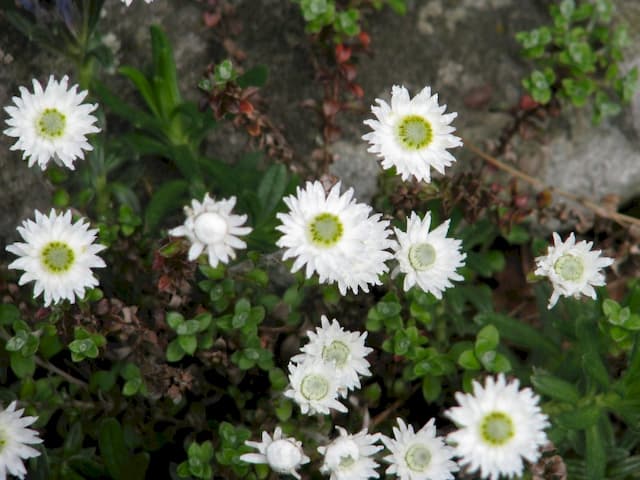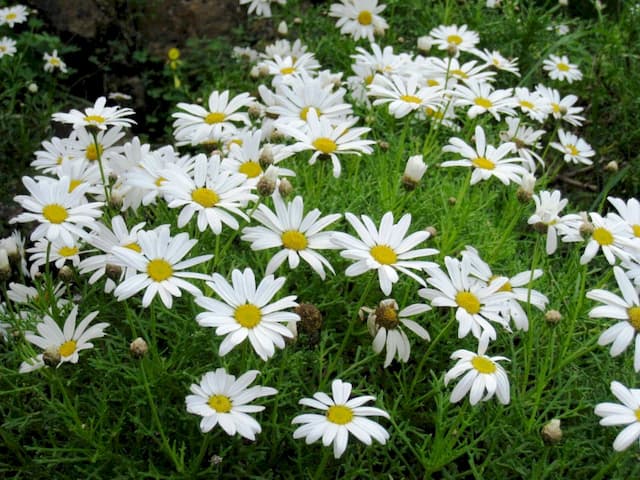Rough Hawkbit Leontodon hispidus

ABOUT
The rough hawkbit is a perennial plant that is immediately recognizable by its dandelion-like flower heads, which consist of numerous tiny yellow florets grouped together to form a single composite flower. These flower heads typically blossom in the warmer months, displaying vibrant yellow petals that attract a variety of pollinators. The plant's leaves are basal, meaning they grow in a rosette at the plant's base rather than up along the stem. These leaves are lance-shaped to oblatory with toothed or deeply lobed edges, giving them a somewhat ragged appearance, and they typically have a rough, hairy texture. The stems are also covered with bristly hairs and hold the flower heads aloft, making them easy to spot in their natural meadow habitats. Once the flowers are spent, they give way to spherical seed heads composed of beak-like fruits that are carried away by the wind, facilitating the spread of the rough hawkbit.
About this plant
 Names
NamesFamily
Asteraceae
Synonyms
Rough Hawkbit, Bristly Hawkbit, Hispid Hawkbit, Beaked Hawkbit, Hairy Hawkbit
Common names
Apargia hispida, Apargia hispidus, Leontodon hispidus var. hastilis, Leontodon hirtus, Leontodon hybridus, Leontodon incanus, Leontodon laevigatus, Leontodon leontodontoides, Leontodon linkii, Leontodon longirostris, Leontodon pratensis, Leontodon sordidus, Leontodon taraxacoides, Leontodon taraxacum, Leontodon vulgaris, Oporinia autumnalis, Oporinia hispida, Oporinia variegata, Picris hispida, Thrincia hirta, Thrincia hispida, Thrincia hispidus.
 Toxicity
ToxicityTo humans
Rough Hawkbit is generally not considered to be a poisonous plant to humans. Therefore, no specific symptoms of poisoning are typically associated with its ingestion. However, as with any plant, individual allergies or sensitivities could potentially cause adverse reactions in some people.
To pets
Rough Hawkbit is not known for being toxic to pets. It is unlikely to cause poisoning if ingested by animals such as dogs or cats. Nonetheless, some pets might experience mild gastrointestinal upset if they consume large quantities of any non-food plant material.
 Characteristics
CharacteristicsLife cycle
Biennials
Foliage type
Deciduous
Color of leaves
Green
Flower color
Yellow
Height
1 foot (30 cm)
Spread
1 foot (30 cm)
Plant type
Herb
Hardiness zones
5
Native area
Europe
Benefits
 General Benefits
General Benefits- Edible Uses: The leaves of the Rough Hawkbit (Leontodon hispidus) can be consumed in salads or cooked as greens, providing a source of food.
- Wildlife Attraction: Its flowers are a nectar source for pollinators such as bees and butterflies, supporting biodiversity.
- Decorative: The bright yellow flowers of the Rough Hawkbit can add aesthetic value to gardens and wildflower meadows.
- Soil Indicator: Presence of Rough Hawkbit can indicate certain soil conditions, such as compaction or specific nutrient levels.
- Cultural History: The Rough Hawkbit has a place in folklore and traditional practices, contributing to cultural heritage.
 Medical Properties
Medical Properties- Diuretic: Leontodon hispidus has traditionally been used to promote the production of urine.
- Cholagogue: It is believed to promote the discharge of bile from the system, aiding in liver function and digestion.
- Appetite stimulant: The plant has been used to stimulate appetite.
- Anti-inflammatory: Leontodon hispidus may have properties that help reduce inflammation.
 Air-purifying Qualities
Air-purifying QualitiesThis plant is not specifically known for air purifying qualities.
 Other Uses
Other Uses- Leontodon hispidus, commonly known as rough hawkbit, has traditionally been used to curdle milk in cheese-making due to its rennet-like properties.
- The flowers of rough hawkbit can produce a yellow to green dye, suitable for coloring textiles and fabrics.
- In some regions, the latex sap of rough hawkbit has been used as an adhesive or a glue for small-scale, domestic repair tasks.
- The plant has been used as a food source for livestock, particularly sheep and goats, when other forage is not available.
- Gardeners may cultivate rough hawkbit for its nectar-rich flowers to attract bees, butterflies, and other beneficial pollinators.
- The plant's dense growth habit can be utilized for ground cover in garden designs or to prevent soil erosion on slopes.
- The seeds of rough hawkbit, like those of other dandelions, can be used in educational activities to demonstrate wind dispersal mechanisms to children.
- In survival situations, the leaves of rough hawkbit can be used as a makeshift bandage due to their slightly antiseptic qualities.
- Rough hawkbit's deep taproot can be exploited in permaculture as a natural means of aerating compacted soils, improving soil structure.
- Culinary enthusiasts sometimes use young leaves of rough hawkbit to add a bitter tang to salads, much like dandelion greens.
Interesting Facts
 Feng Shui
Feng ShuiThe Rough Hawkbit is not used in Feng Shui practice.
 Zodiac Sign Compitability
Zodiac Sign CompitabilityThe Rough Hawkbit is not used in astrology practice.
 Plant Symbolism
Plant Symbolism- Determination: The common name "Rough Hawkbit" reflects the plant's ability to thrive in challenging conditions, symbolizing determination and the ability to overcome obstacles.
- Survival: As a hardy perennial, the Rough Hawkbit can symbolize survival and resilience in the face of adversity.
- Opportunism: With its nature to grow in a variety of environments, the Rough Hawkbit may represent taking advantage of opportunities that come one's way.
 Water
WaterRough hawkbit, another name for Leontodon hispidus, does best with moderate watering, allowing the soil to dry out somewhat between waterings to mimic its natural habitat. Water the plant using a gentle shower from a watering can to wet the soil thoroughly without flooding it, roughly providing up to 16 ounces of water once or twice a week. Adjust the frequency depending on the temperature and humidity; less often during cooler months, and more frequently during hot periods. Avoid overwatering, as this can lead to root rot.
 Light
LightRough hawkbit thrives in full sunlight conditions, so it's best to position it in a spot where it can receive at least six hours of direct sunlight daily. A south-facing garden or window is ideal for this plant, as it ensures plenty of natural light throughout the day. Avoid placing it in deep shade or low light areas, as inadequate light can hinder its growth and flowering.
 Temperature
TemperatureRough hawkbit prefers a temperate climate, with ideal temperatures for growth between 50°F and 77°F. The plant can withstand a range of temperatures, but frost can damage it. Ensure that it is not exposed to temperatures below 32°F for extended periods, as cold temperatures can be detrimental to its health.
 Pruning
PruningPruning rough hawkbit is not commonly necessary but doing so can encourage a bushier growth and remove any spent flowers or damaged leaves. Lightly trim the plant after blooming, or as needed, to maintain shape and promote new growth. The best time for pruning is late summer or early fall, before the plant prepares for dormancy.
 Cleaning
CleaningAs needed
 Soil
SoilRough Hawkbit (Leontodon hispidus) thrives in well-drained soil that is moderately fertile. A good mix for this plant would include loamy or sandy soil with added compost to ensure fertility. The soil pH should be neutral to slightly alkaline, ideally ranging between 6.5 and 7.5. Retaining some moisture while also allowing excess water to drain away will create a suitable environment for Rough Hawkbit.
 Repotting
RepottingRough Hawkbit generally does not require frequent repotting and can thrive in the same pot for several years. Repotting every 2 to 3 years or when the plant outgrows its current container is sufficient. Ensure to provide fresh soil mix during repotting to replenish nutrients.
 Humidity & Misting
Humidity & MistingRough Hawkbit is not particularly demanding regarding humidity and can adapt to a range of atmospheric moisture levels. It typically does well in the natural outdoor humidity found in its native range. There is no specific humidity level required, but average room humidity should be adequate for indoor growing.
 Suitable locations
Suitable locationsIndoor
Ensure bright light and well-drained soil for Rough Hawkbit.
Outdoor
Plant in well-drained, fertile soil; full sun to partial shade.
Hardiness zone
4-8 USDA
 Life cycle
Life cycleLeontodon hispidus, commonly known as the Rough Hawkbit, begins its life cycle as a seed, germinating in the spring when temperatures are suitable. Upon germination, it develops a basal rosette of leaves close to the ground, where it undergoes vegetative growth. The plant then matures and produces a flowering stalk, typically in late spring to early summer, with yellow dandelion-like flowers that are pollinated by insects. After pollination, seeds form in spherical brown seed heads that disperse primarily through wind or animal movement. The Rough Hawkbit is a perennial plant, meaning once it has flowered, it can go into a dormant phase during colder months, and then resume growth from its rootstock the following spring. Throughout its life, the plant will repeat the flowering and seed dispersal phases, spreading to new locations and ensuring the continuation of its species.
 Propogation
PropogationPropogation time
Spring to Summer
Leontodon hispidus, commonly known as the rough hawkbit, primarily reproduces through seeds. The best time to propagate by seed is in the spring or late summer after the danger of frost has passed. To propagate rough hawkbit using seeds, scatter them directly onto a well-drained, loamy soil surface where you intend for the plants to grow. Lightly press the seeds into the soil but do not cover them, as they need light to germinate. Keep the soil moist until germination, which should occur within two to three weeks. Once the seedlings have developed a couple of true leaves and are large enough to handle, thin them out to a spacing of about 6 to 8 inches (approximately 15 to 20 centimeters) to allow the plants enough space to mature. This method of propagation is popular because of its simplicity and the plant's ability to self-sow in suitable conditions.









